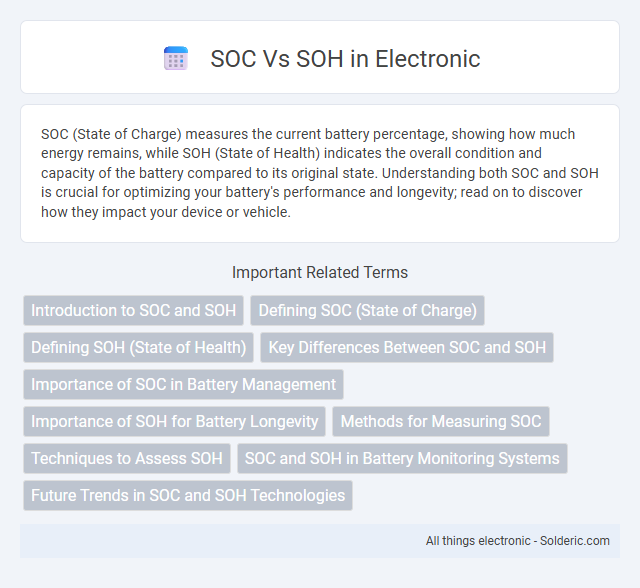SOC (State of Charge) measures the current battery percentage, showing how much energy remains, while SOH (State of Health) indicates the overall condition and capacity of the battery compared to its original state. Understanding both SOC and SOH is crucial for optimizing your battery's performance and longevity; read on to discover how they impact your device or vehicle.
Comparison Table
| Feature | SOC (State of Charge) | SOH (State of Health) |
|---|---|---|
| Definition | Current battery charge level relative to maximum capacity | Overall battery condition relative to its original performance |
| Measurement Unit | Percentage (%) | Percentage (%) |
| Purpose | Indicates remaining usable energy | Assesses battery degradation and lifespan |
| Typical Use Case | Real-time energy management in devices and vehicles | Battery maintenance, warranty assessment, and performance monitoring |
| Calculation Method | Measured via voltage, current, and coulomb counting | Determined through capacity tests, internal resistance, and diagnostic data |
| Impact | Directly affects device runtime and operation | Influences battery replacement decisions and reliability |
Introduction to SOC and SOH
State of Charge (SOC) measures the remaining battery capacity as a percentage of its total charge, indicating the current energy level available for use. State of Health (SOH) assesses the overall condition and performance of the battery compared to its ideal, monitoring factors like capacity loss, internal resistance, and aging. Both SOC and SOH are critical metrics for battery management systems to optimize battery life, performance, and safety.
Defining SOC (State of Charge)
State of Charge (SOC) quantifies the current energy level of a battery as a percentage of its total capacity, reflecting the amount of charge remaining compared to its full charge state. SOC is critical for battery management systems to monitor and optimize performance, ensure safe operation, and extend battery lifespan. Accurate SOC estimation involves measuring voltage, current, and temperature, combined with algorithms such as Coulomb counting or electrochemical modeling.
Defining SOH (State of Health)
State of Health (SOH) measures the overall condition and remaining lifespan of a battery by evaluating its capacity, internal resistance, and efficiency compared to when it was new. Monitoring SOH helps predict battery performance and inform maintenance or replacement decisions. Understanding your battery's SOH ensures reliable operation and optimal energy management.
Key Differences Between SOC and SOH
State of Charge (SOC) measures the current battery capacity relative to its maximum, expressed as a percentage indicating available energy for use. State of Health (SOH) evaluates the overall condition and performance of the battery by comparing its current ability to hold charge against its original specifications. Key differences include SOC representing real-time energy status, while SOH reflects long-term battery degradation and lifespan.
Importance of SOC in Battery Management
State of Charge (SOC) is crucial in battery management as it indicates the current energy level relative to the battery's capacity, enabling accurate monitoring and optimization of battery performance. Proper SOC measurement helps prevent overcharging and deep discharging, which can extend battery lifespan and maintain safety. Your device relies on precise SOC data to manage power usage efficiently and ensure reliable operation.
Importance of SOH for Battery Longevity
State of Health (SOH) is a critical metric for assessing battery longevity as it indicates the overall condition and capacity degradation over time. Maintaining a high SOH ensures optimal battery performance, reduces the risk of unexpected failures, and extends the device's operational lifespan. Accurate SOH monitoring enables predictive maintenance strategies, maximizing the efficiency and durability of lithium-ion batteries in electric vehicles and renewable energy storage systems.
Methods for Measuring SOC
Methods for measuring State of Charge (SOC) include Coulomb counting, which tracks the net current flowing in and out of the battery, providing real-time charge estimation. Open-circuit voltage (OCV) measurement offers SOC insight by correlating battery voltage at rest to charge levels, though it requires the battery to be idle for accuracy. Kalman filtering uses complex algorithms combining current, voltage, and temperature data to deliver precise SOC estimates, enhancing your battery management system's reliability.
Techniques to Assess SOH
Techniques to assess State of Health (SOH) of batteries include electrochemical impedance spectroscopy (EIS), which analyzes internal resistance changes over time, and capacity fade tests that measure the reduction in charge capacity compared to the original specification. Advanced machine learning algorithms process data from voltage, current, and temperature sensors to predict SOH with higher accuracy by identifying complex degradation patterns. You can leverage these methods to ensure timely maintenance and extend battery lifespan effectively.
SOC and SOH in Battery Monitoring Systems
SOC (State of Charge) measures the current energy level of a battery as a percentage of its full capacity, providing real-time insight into how much charge remains. SOH (State of Health) evaluates the overall condition and performance degradation of the battery over time, indicating its ability to store and deliver energy effectively. Accurate monitoring of both SOC and SOH in Battery Monitoring Systems enables you to optimize battery usage, prolong lifespan, and ensure reliable performance in critical applications.
Future Trends in SOC and SOH Technologies
Future trends in State of Charge (SOC) and State of Health (SOH) technologies emphasize enhanced battery management systems leveraging machine learning algorithms for more accurate predictions. Advances in sensor technology and AI-driven data analytics enable real-time monitoring of battery performance, optimizing your device's lifespan and efficiency. Integration of cloud-based platforms for SOC and SOH diagnostics facilitates proactive maintenance and improved energy management in electric vehicles and portable electronics.
SOC vs SOH Infographic

 solderic.com
solderic.com